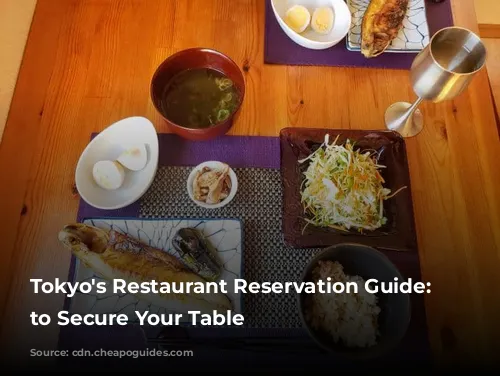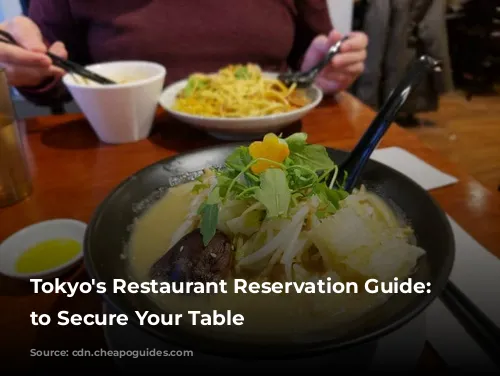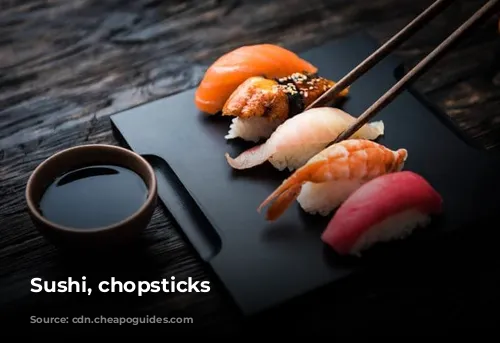Craving delicious food in Tokyo? You’re in luck! The city is a culinary paradise, offering everything from Michelin-starred restaurants to casual eateries. But with so many great options, securing your table can be a challenge, especially if you’re aiming for a specific spot. Let’s explore the ins and outs of restaurant reservations in Tokyo, ensuring you get the best dining experience.

Reservations: When are They Necessary?
Just like in many parts of the world, booking a table in advance is wise, especially for popular and fancy restaurants. This includes those Michelin-rated gems, which often offer surprisingly affordable prices. Even on weekdays, it’s best to secure your spot. Tokyo is a bustling city with many hungry foodies!
Larger groups (5-6 people or more) often benefit from reservations, especially if you desire a private room, a special menu, or have dietary restrictions. Discussing your needs beforehand helps ensure the restaurant can accommodate your preferences.
Be aware that some restaurants may not accept reservations or only offer them for dinner. This is common in smaller or highly popular spots that see a lot of walk-in customers during lunchtime.

Places Where Reservations are Unnecessary
For budget-friendly chains and other casual restaurants, you can usually walk right in. The same goes for izakayas, although calling ahead is a good idea for larger groups.
Before heading out, consider brushing up on basic Japanese restaurant phrases to enhance your dining experience.

Booking Your Table: The Essentials
In Japan, restaurant reservations can be made through two main methods:
If you’re near the restaurant and comfortable speaking Japanese, you can always book in person. However, the most common methods are phone calls and online booking services.
For those with basic Japanese skills, calling the restaurant is straightforward. Simply provide the date, time, and number of people in your party. Alternatively, online reservation services like Gurunavi, Hot Pepper, Tabelog, Rakuten, and others offer user-friendly platforms for booking your table.
Navigating Reservations in English
While some restaurants, particularly those frequented by international visitors, may handle English phone calls, the majority are likely to be more comfortable with Japanese. Don’t worry, there are still great options for English speakers!
Your hotel concierge can be a lifesaver when booking a restaurant. Additionally, several websites and apps facilitate English bookings. Some restaurants include booking links on their Google Maps listings or are featured on platforms like TableCheck. However, not all restaurants are tech-savvy.
That’s where dedicated English booking services come in!
English Booking Services: Your Gateway to Deliciousness
These handy services streamline the reservation process. Simply submit your request, and let the magic happen! While confirmation times and fees may vary, rest assured that these services have you covered.
It’s important to note that using an English service doesn’t guarantee an English menu or English-speaking staff at the restaurant. While you might be in luck, always pack a phrasebook for peace of mind.
ByFood is a fantastic resource for booking top-notch restaurants in Tokyo. Their website allows you to filter restaurants by location, Michelin stars, and even dietary needs. You’ll find information about opening hours, cancellation policies, and average meal costs. Once you’ve selected a restaurant, you can specify your desired date, time, and number of people. A transparent reservation fee is displayed, typically around ¥2,000.
ByFood also offers a variety of food experiences, such as cooking classes, farm visits, and food tours. Their gourmet product section functions as an online shop, allowing you to purchase quality ingredients for home cooking.
One of the most rewarding aspects of ByFood is their Food for Happiness project, where a portion of every booking or purchase is donated to support children in need around the world. By booking with them, you can indulge in delicious food while contributing to a good cause.
Another reliable option for English restaurant reservations is Klook, although their Tokyo restaurant selection is relatively smaller. They feature restaurants offering exceptional Japanese cuisine, including three Michelin-starred establishments.
Klook allows you to pre-order your meal from a range of menu options, ensuring speedy service. Reservation and meal fees are combined, eliminating any surprises at the checkout. You can conveniently pay with your credit card, including American Express, which is not always an option at Japanese restaurants. Klook also offers unique food experiences, like food tours, cooking classes, and even a Maid Cafe adventure.
Rakuten Travel Experiences provides reservations for a select group of high-end sushi, shabu-shabu, and okonomiyaki restaurants in Tokyo. They even offer a reservation at Sukiyabashi Jiro Roppongi, run by legendary sushi master Jiro’s son. You can also find dinner cruises in Tokyo Bay and foodie walking tours on their platform.
Essential Tips for Restaurant Reservations
Before heading out, keep these unspoken rules in mind:
Punctuality is key! Aim to arrive 5-10 minutes early. Being even 5-15 minutes late can result in your reservation being cancelled and might lead to less-than-friendly service.
Avoid cancelling unless absolutely necessary. If you do need to cancel, give the restaurant as much notice as possible to allow them to rearrange their seating and avoid potential losses. High-end restaurants may impose hefty cancellation fees.
Your reservation doesn’t guarantee an all-day stay. As is customary in Japanese dining, you’re expected to vacate the restaurant within a couple of hours, especially if it’s busy and other patrons are waiting.
Booking Timing: A Quick Guide
For most restaurants, a week or two in advance should suffice. However, renowned and upscale establishments, including those with Michelin stars, require reservations much earlier. Aim for 1-2 months, or even 6+ months in advance!
Handling Booking Changes
Life happens, and you may need to modify your reservation. Adding extra guests is usually manageable. Changing the date, however, can be trickier. If you booked through an English service, check their policy for assistance. If you made the reservation yourself, it’s best to call the restaurant (if you’re comfortable speaking Japanese) or cancel the booking and make a new one.
Selecting Your Booking Time
The best time to book depends on your preferences. Weekends, national holidays, and special occasions like Valentine’s Day tend to be fully booked. Many restaurants are closed on Sundays, Mondays, and Tuesdays. If you’re aiming for an exclusive restaurant, try booking mid-week close to their opening time. For a more relaxed dining experience, opt for casual restaurants on weekends or busy evenings.
Enjoy your culinary adventures in Tokyo! Remember to plan ahead, embrace the culture, and savor the flavors!

